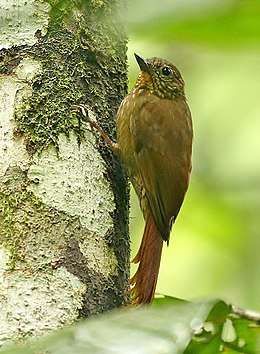Wedge-billed woodcreeper
The wedge-billed woodcreeper (Glyphorynchus spirurus), is a passerine bird which breeds in the tropical New World from southern Mexico to northern Bolivia, central Brazil and the Guianas; it is absent from the Pacific coastal areas except between Costa Rica and Ecuador. It is the only member of the genus Glyphorynchus.
| Wedge-billed woodcreeper | |
|---|---|
 | |
| at Rio Silanche (PVM), NW Ecuador | |
| Scientific classification | |
| Kingdom: | Animalia |
| Phylum: | Chordata |
| Class: | Aves |
| Order: | Passeriformes |
| Family: | Furnariidae |
| Genus: | Glyphorynchus Wied-Neuwied, 1831 |
| Species: | G. spirurus |
| Binomial name | |
| Glyphorynchus spirurus (Vieillot, 1819) | |
| Synonyms | |
| |
It is easily distinguished from its relatives by its small size and distinctive bill. The wedge-billed woodcreeper is typically 14–15 cm long, and weighs 14–16.5 g. It has brown upperparts, with fine streaking on the head sides, a buff supercilium, and a chestnut rump, wings and tail. The throat is buff, and the rest of the underparts are brown spotted with buff chevrons, most heavily on the breast. A buff wing bar is obvious from below in flight. The short wedge-shaped bill is quite different in shape from that of other woodcreepers. Young birds are duller with less distinct breast streaking.
The call is a sneezy schip. The song varies geographically, perhaps reflecting the different subspecies of this bird. In Costa Rica it is a trilled keekekekiki, whilst in eastern Bolivia it is an ascending too-e too-e tu-tu-tu-tue-twu-twu-tweeet.
This common and widespread small woodcreeper is found in lowlands up to 1500 m altitude, although normally below 1100 m, in damp forests, adjacent semi-open woodland and old second growth. It feeds on small spiders and insects, creeping up trunks and extracting its tiny prey from the bark. It has a strong preference for trees with fine flaky bark. It is seen alone, in pairs, or sometimes as part of a mixed-species feeding flock. Birds are largely resident, but may disperse locally. For example, a vagrant individual was observed on May 12, 1998 at Cerro Campana, El Salvador, the first record for that country.[2]
It builds a cup nest in a narrow tree cavity such as a rotting stump or space between buttresses. It may occasionally nest up to 6 m high in a tree, but is usually much lower, often at or below ground level. It lays two white eggs between March and June.
Footnotes
- BirdLife International (2012). "Glyphorynchus spirurus". IUCN Red List of Threatened Species. 2012. Retrieved 26 November 2013.CS1 maint: ref=harv (link)
- Herrera et al. (2006)
References
- Herrera, Néstor; Rivera, Roberto; Ibarra Portillo, Ricardo & Rodríguez, Wilfredo (2006): Nuevos registros para la avifauna de El Salvador. ["New records for the avifauna of El Salvador"]. Boletín de la Sociedad Antioqueña de Ornitología 16(2): 1-19. [Spanish with English abstract] PDF fulltext
- Hilty, Steven L. (2003): Birds of Venezuela. Christopher Helm, London. ISBN 0-7136-6418-5
- Stiles, F. Gary & Skutch, Alexander Frank (1989): A guide to the birds of Costa Rica. Comistock, Ithaca. ISBN 0-8014-9600-4
